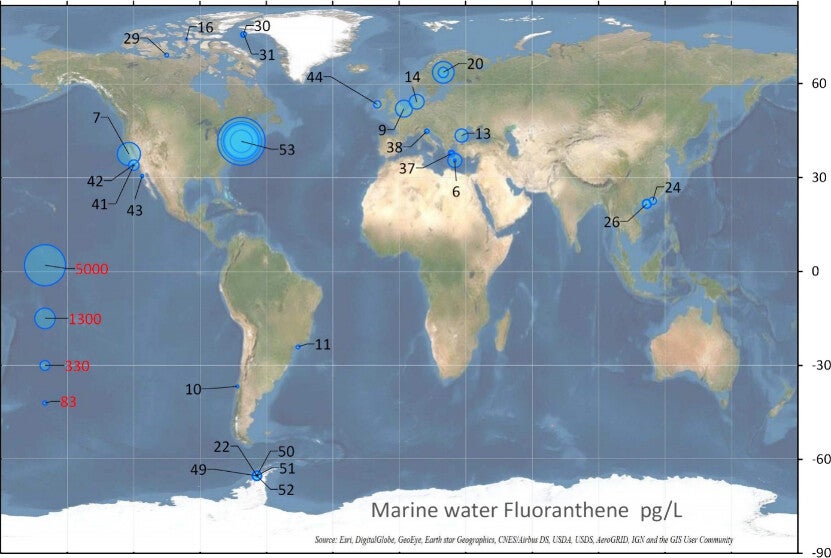While PFAS are a primary focus at STEEP, our diverse team of scientists study a breadth within environmental health. STEEP Director Rainer Lohmann, PhD, wears many hats, including that of lead author on a recent study through AQUA-GAPS/MONET. This group integrates international scientists using passive sampler technology to measure persistent organic pollutants (POPs) around the globe.
Unfortunately, our environment is threatened by contaminants beyond PFAS, and a recent study published in Environmental Science & Technology focuses on global water concentrations of polycyclic aromatic hydrocarbons (PAHs) and polycyclic musks (PCMs). PAHs are unique because production cannot be limited as other contaminants, like PFAS. PAHs are produced by combustion (called pyrogenic PAHs), for example, when vast forest fires burn down trees. PAHs are also produced by fossil fuel burning (called petrogenic PAHs), exacerbated by ongoing use of oil and gas. PCMs are actively produced by industry, and are used in personal care products. While these contaminants have been studied in the past, little is known about the global level of contamination in our surface waters.
Enter AQUA-GAPS/MONET. In a project that included 21 countries, 27 collaborators, and 46 sampling sites in both marine and freshwater, Lohmann et al. identified that PAH and PCM concentrations are generally correlated to population density. Based on the results of passive sampler deployments, research found where there are more people, there are more pollutants. However, below average contamination was still reported in remote regions, including the Arctic, Antarctic, and mountain lakes.
The study concludes there are still understudied regions for exploration in future iterations of AQUA-GAPS/MONET. Sampling of Africa, Australia, tropical Asian countries, and the Arctic will be vital to further enhancing our global understanding of contaminant transport from source to sea. This research exemplifies how similar science may be conducted for global PFAS, as it is increasingly apparent that few areas remain untouched by pollution.
Rainer Lohmann, Branislav Vrana, Derek Muir, Foppe Smedes, Jaromir Sobotka, Eddy Y. Zeng, Lian-Jun Bao, Ian J Allan, Peleg Astrahan, Terry Bidleman, Denis Crowley, Evgen Dykyi, Nicolas Estoppey, Gilberto Fillmann, Liisa Jantunen, Sarit Kaserzon, Keith A. Maruya, Brendan McHugh, Brent Newman, Raimon M. Prats, Manolis Tsapakis, Mats Tysklind, Barend L. van Drooge, and Charles S. Wong. AQUA-GAPS/MONET-Derived Concentrations and Trends of PAHs and Polycyclic Musks across Global Waters. Environmental Science & Technology 2024 58 (30), 13456-13466.


